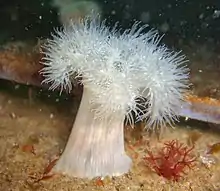Metridium dianthus
Metridium dianthus is a species of sea anemone in the family Metridiidae.[1] It is found in the northern Atlantic Ocean (including the coasts of the British Isles) and in the northeast Pacific Ocean. There is also a record from South Africa, possible resulting from an introduction.[2]
| Metridium dianthus | |
|---|---|
 | |
| Scientific classification | |
| Domain: | Eukaryota |
| Kingdom: | Animalia |
| Phylum: | Cnidaria |
| Class: | Hexacorallia |
| Order: | Actiniaria |
| Family: | Metridiidae |
| Genus: | Metridium |
| Species: | M. dianthus |
| Binomial name | |
| Metridium dianthus (Ellis, 1768)[1] | |
| Synonyms[1] | |
| |
Description
This is the largest sea anemone in the northeastern Atlantic; the smooth column can be 30 cm (12 in) in height with a pedal disc wider than this. This form is known as "dianthus" and on a large specimen, the oral disc may have a plume of several thousand tentacles some 15 cm (6 in) across, often forming several lobes. A smaller form, found most often in brackish water, is known as "pallidus" and may have two hundred tentacles and be 2.5 cm (1 in) across.[3]
Distribution and habitat
Metridium dianthus is an adaptable, circumboreal species in the Northern Hemisphere. In the eastern Atlantic, its range extends from the Kola Peninsula in northern Russia to the Bay of Biscay, in the western Atlantic from the Arctic Circle to Delaware, and it also occurs in the northeastern Pacific. It is also present in certain locations where it has probably been introduced, including Patagonia, the Falkland Islands, South Africa and Japan. It occurs at depths down to about 100 m (330 ft), on rocks, in caves, on pebbles, on molluscs such as mussels, on wharves and jetties, on floating objects, nets and ropes. It tolerates temperatures between −1 and 20 °C (30 and 68 °F) and a range of salinities.[3]
Ecology
Metridium dianthus is a suspension feeder, spreading its plume of tentacles and catching small organisms as they float past. These include the eggs and larvae of molluscs, polychaetes, ascidians, amphipods, copepods, barnacles, shrimps and other crustaceans, as well as foraminifera and diatoms. When there is either too strong a current, or very little water movement, it can retract both the plume of tentacles and the column.[3]
The sexes are separate in this species and, in Scotland, spawning takes place in June and July. Batches of eggs are emitted by the female at intervals of two to ten days, not through the siphonoglyphs, as might be expected, but through slits in the body wall known as cinclides. The eggs sink to the seabed and are fertilised in the water column. The planula larvae are planktonic, before sinking to the seabed and undergoing metamorphosis into juveniles.[4]
References
- Fautin, Daphne (2015). "Metridium dianthus (Ellis, 1768)". WoRMS. World Register of Marine Species. Retrieved 2 August 2018.
- Hiscock, K.; Wilson, E. (2007). "Plumose anemone (Metridium dianthus)". Marine Life Information Network: Biology and Sensitivity Key Information Reviews. Marine Biological Association of the United Kingdom. Retrieved 5 September 2020.
- Ziemski, Frédéric; Prouzet, Anne (9 November 2020). "Metridium dianthus (Ellis, 1768)" (in French). DORIS. Retrieved 28 August 2021.
- Gemmill, James F. (1920). "The Development of the Sea-Anemones Metridium dianthus (Ellis) and Adamsia palliata (Bohad)". Philosophical Transactions of the Royal Society B. 209 (360–371). doi:10.1098/rstb.1920.0009.